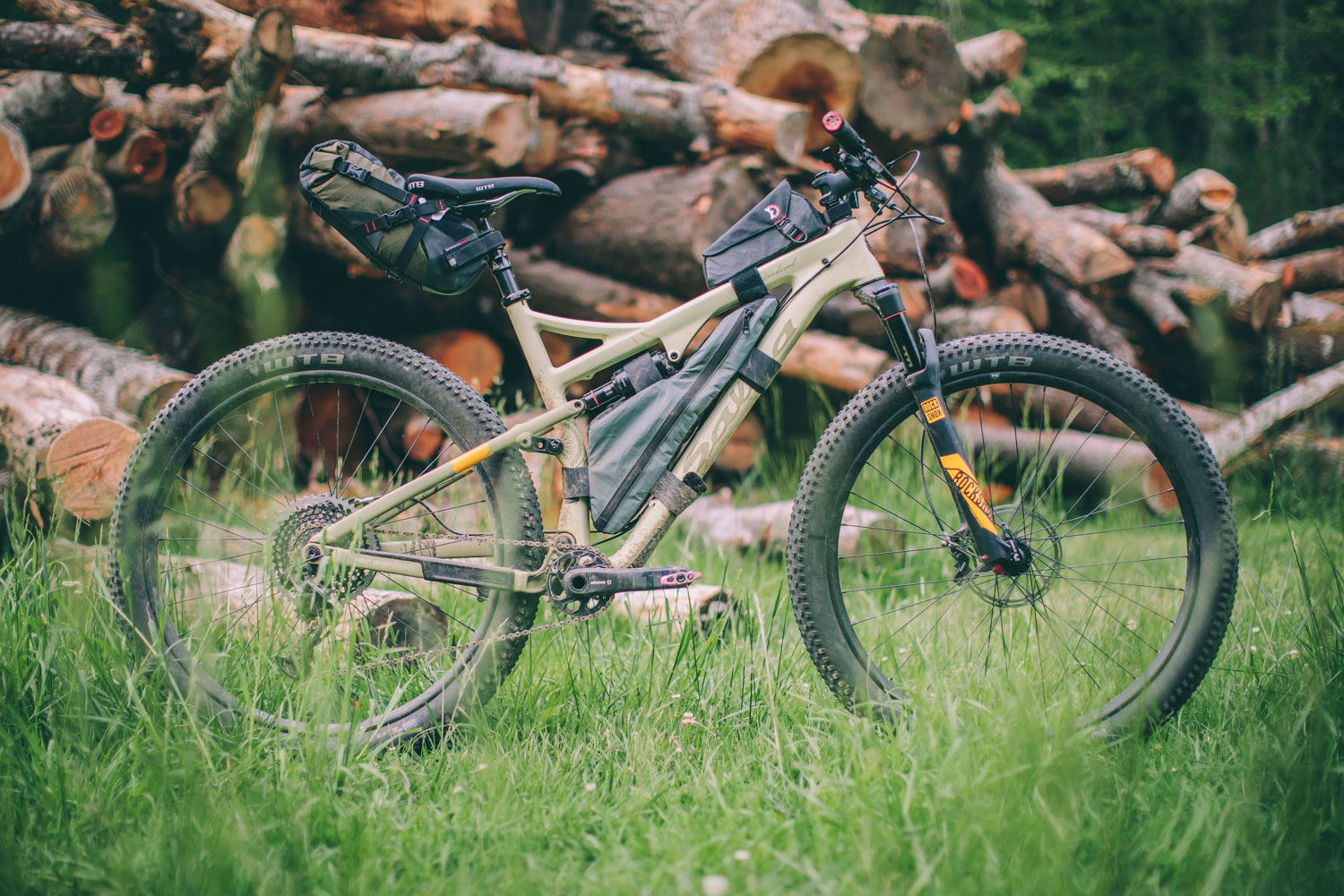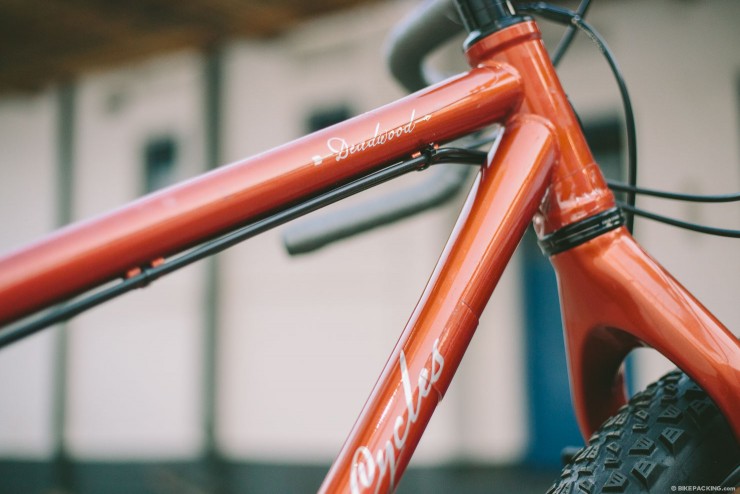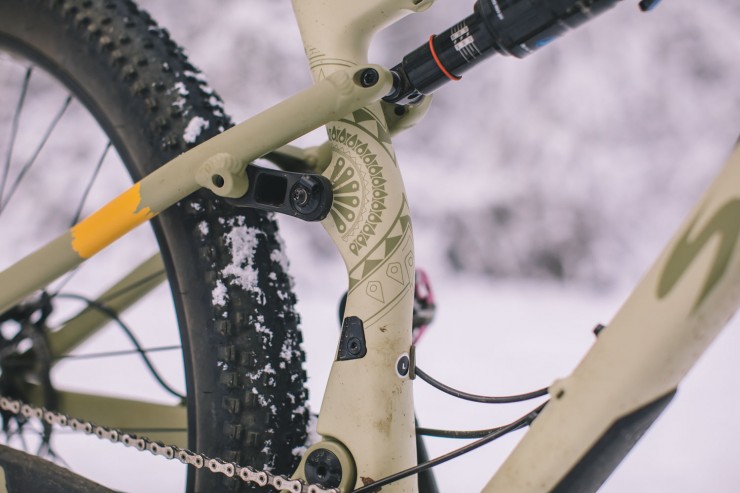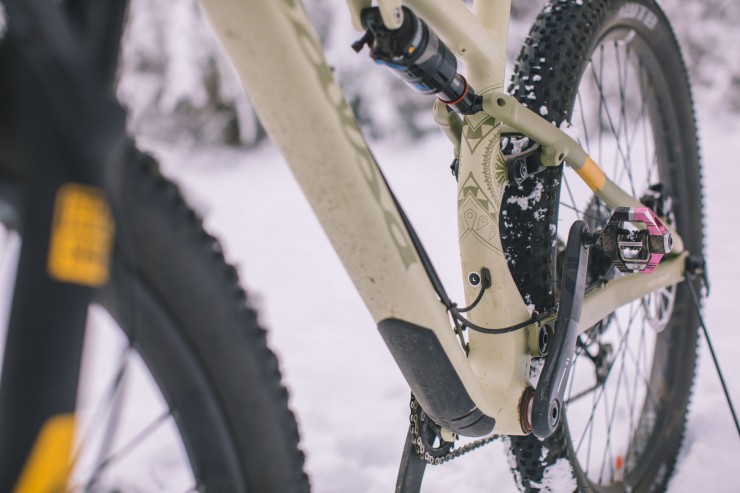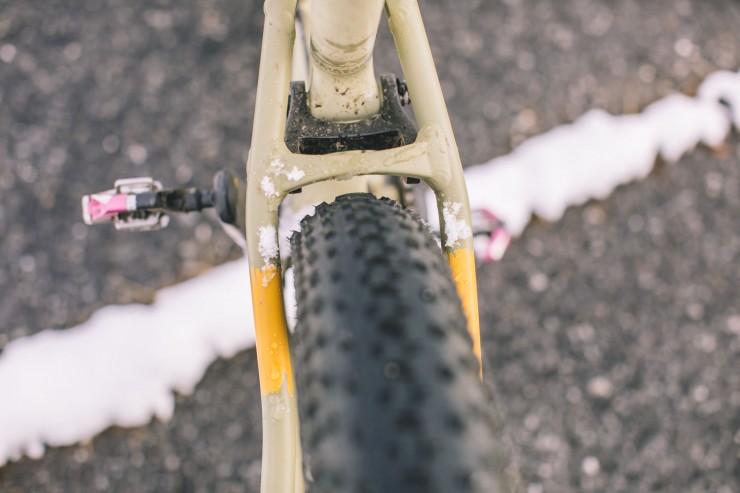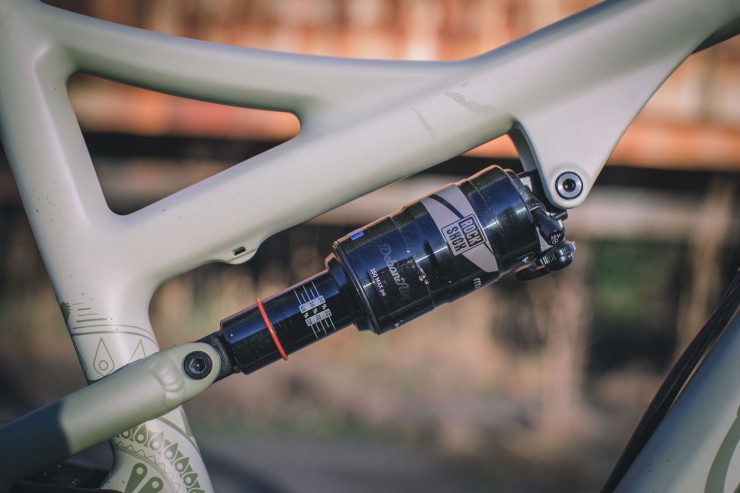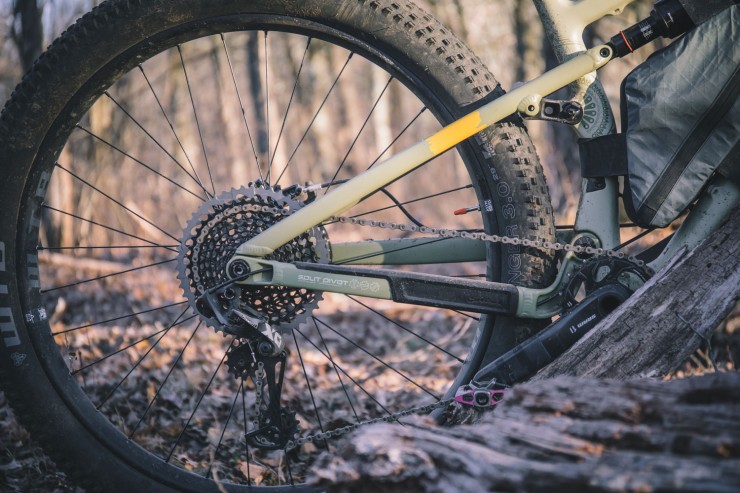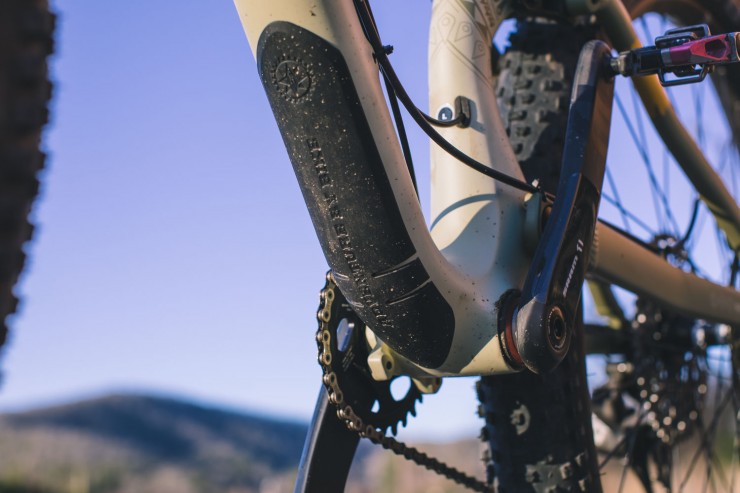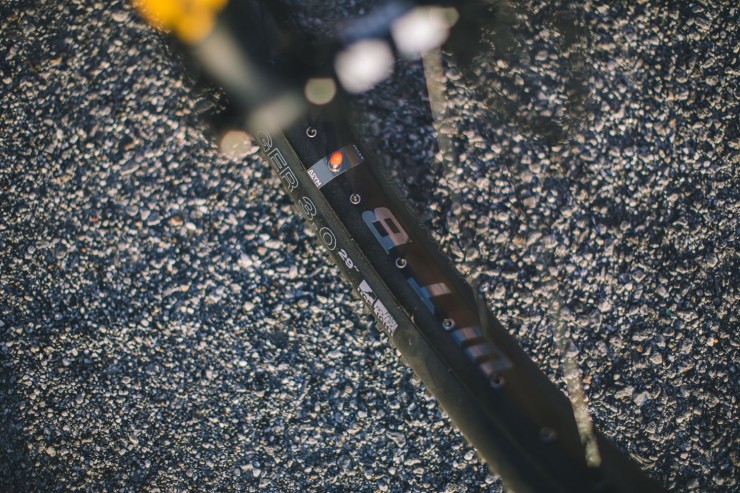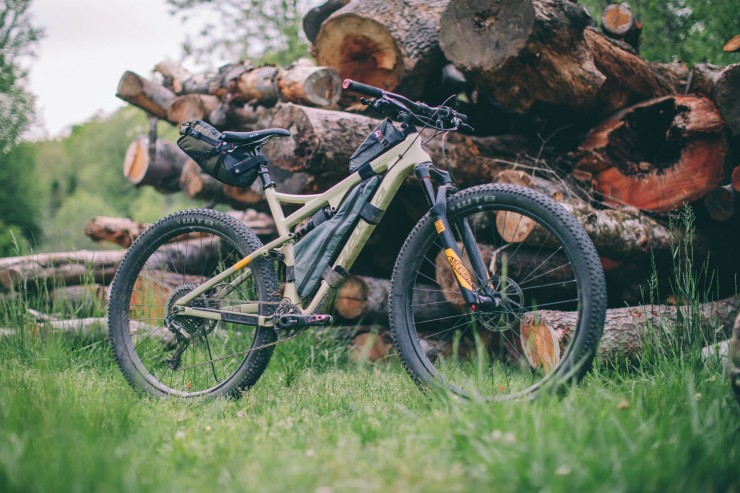Salsa Deadwood SUS Review: This bike is for…
Share This
Aside from those strapping 29×3” tires, Deadwood “the sequel” SUS shares just one similarity with the original steel dropbar bike of the same name — it makes folks wonder. We took the 29+ Deadwood SUS on flow trails, dirt roads, gnarly singletrack, and into the backcountry trying to make heads or tails of this curiosity…
Normally I try to weave a story into bike reviews in order to keep them interesting, or at least interesting to write. Each one typically involves some sort of contextual rambling to set the tone for discussing the bike in question. However, for this one I am getting straight to the point. Even though it may be considered ultra-niche to some, the new Salsa Deadwood SUS is a versatile machine that has people wondering just what this bike is all about. So here’s exactly what this bike is, where it came from, who it’s for, and why… as well as points about how this bike and it’s components performed on the trail over several hundred miles and a couple months of testing.
(What) The Salsa Deadwood SUS is not.
Released in the 2016 model year lineup, the original Salsa Deadwood was designed for dirt road exploration with a rigid steel frame, drop-handlebars, and 29+ tires. It looked like the perfect vehicle for scouting a 1,300 mile dirt-centric bikepacking route in East Africa. So we set one up and took it to Uganda and Rwanda where it proved its worth in spades. I say ‘was’ because the original Deadwood was a one-off creation replaced this year by the latest Fargo, specced with a 27.5+ wheel/tire combination but also capable of fitting 29+ hoops.
When the news broke that Salsa nixed the Deadwood from their 2017 line — even though it technically lived on in new Fargo — folks scratched their heads. Not because it was some must-have, do-all bike for the masses, but because it had one of the greatest product names Salsa’s marketing team has ever conjured (although the Coen brothers inspired “Fargo” followed by the “Woodchipper” handlebar was pretty damned clever too). Fast forward to March of this year in Harrisonburg, VA when Salsa lifted the curtain on Deadwood “the sequel” SUS and there was a collective sigh of puzzled relief.

The return of Deadwood sports a carbon, full-suspension frame, a dropper seatpost, hydraulic brakes, and a 1x drivetrain — 1×12 Eagle on the X01, or 1×11 on the XT or GX builds. It’s a bike that’s completely divergent from its 2×10, BB7-equipped forebear, even in the details. Given the stark contrast between the 2016 rigid model and the 2017 SUS, one might assume that a new and unique take on the “Deadwood” will be launched each model year. That’s highly doubtful, but it is perfectly clear that the Deadwood name is rooted in the 29+ platform. And while 27.5+ has seemingly overshadowed its bigger brother, we’re stoked to see the 29+ torch being carried forward, alive and well.
Salsa positions this bike somewhere between their 80mm endurance-XC Spearfish and the enduro Red Point. I think it’s more inline with the 27.5+ Pony Rustler. In fact, the Deadwood uses the same carbon front-end as the Pony Rustler with a different alloy rear triangle and linkage to accommodate the larger wheels and tires and a shorter shock.
(Who) The Deadwood SUS is for…
The name gets the ‘SUS’ addition for obvious reasons. With just 91 millimeters of rear travel and 100 millimeters of squish at the front — either a RockShox Pike on the X01 or XT builds, or a Yari on the GX — the Deadwood SUS is, without a doubt, a short travel bike. A ~100mm bike might conjure images of sinewy, spandex-clad racers arched over super-lightweight, narrow-barred XC rigs, but that’s not who the Deadwood’s for. The chunky wagon-wheel 29×3.0” tires should quickly curb any thoughts of lightening-quick finishes to the podium. According to Salsa, the Deadwood SUS is designed for trail-riding and “connecting widely-spaced points on unfamiliar maps”. I would agree with that sentiment and add that, more specifically, it was designed for those of us who went all weak-kneed over the Krampus back when Surly invented 29+ — or folks who liked the idea of the original Deadwood but wanted a rig more apt for gnarly singletrack.
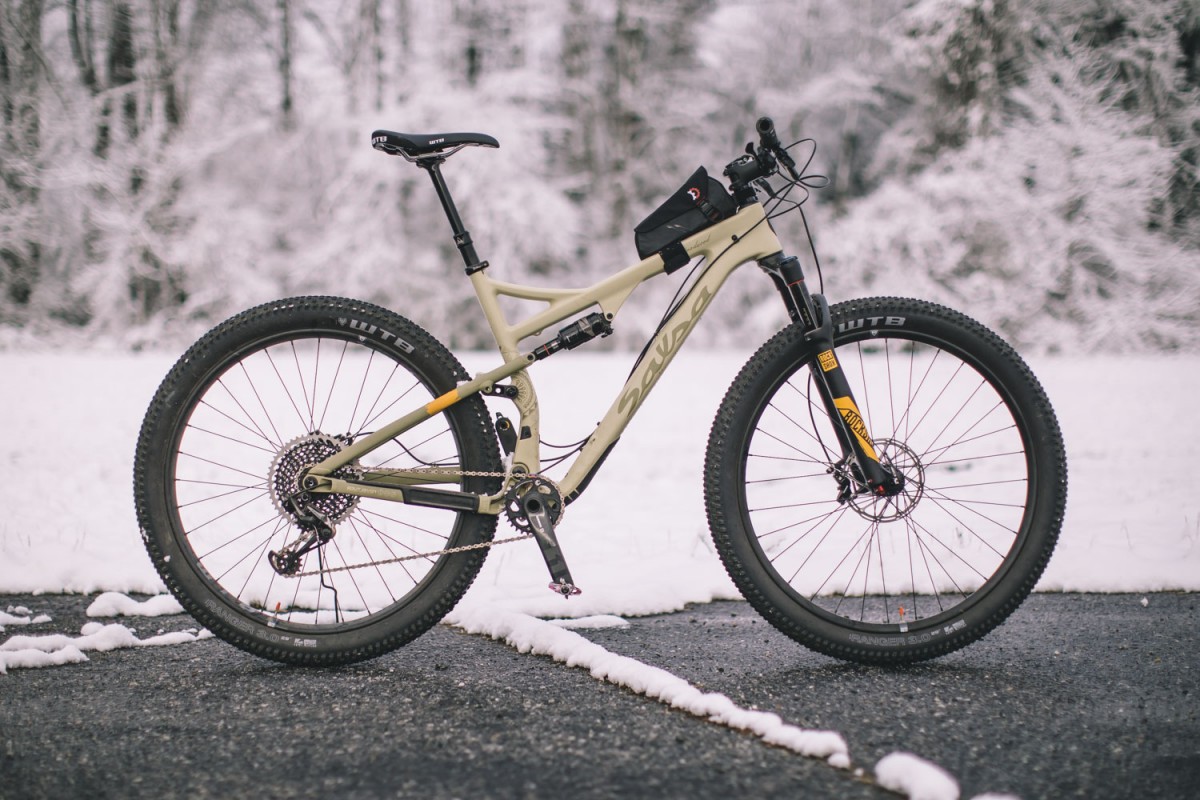
The first thing that came to mind when Salsa released the SUS was the same thing that’s been rattling in my head — quite literally sometimes — for a long time, “Wouldn’t it be kinda cool if there was a version of the Krampus that had just a little suspension?” Of course that’s after a multi-year romp with the rigid Krampus and ECR combo, for everything from dirt-road odysseys to the Kokopelli Trail, to singletrack throwdowns at the likes of Sedona, Pisgah, Hurricane, and Moab. The Krampus’ high-volume tires combined with a long and somewhat slack geometry make all kinds of riding doable on a rigid frame. And that is what makes it such an enticing bike with a zealous cult following. Many in that fan club might insist that rigid 29+ is the end-all-be-all platform. But there are others who have been eagerly awaiting the right full-suspension iteration to emerge.
That said, the Deadwood SUS is not a full-suspension 29+ bike that was engineered just for the sake of the idea. In fact, the concept behind it makes a lot of sense: match solid trail-oriented geometry with a short-travel suspension design, a good fork, and voluminous 2.8-3” tires. The name of the game being the right amount of travel, just enough to amplify the ultra-sticky, stable and confidence inspiring benefits of 29+. The challenge for Salsa was to fit 29×3” tires into a full-suspension frame while maintaining a geometry that wouldn’t sacrifice the bike’s playfulness. Salsa successfully pulled it off via their fairly compact Split Pivot suspension design.
Notes on the suspension
The Deadwood SUS X01 is equipped with a RockShox Monarch RT3 in the rear and a Pike RC 100mm in the front. On first glance I was a little put off that neither lock out, and the ‘firmest’ setting on each didn’t really change as much as expected. However, after a couple rides that quickly became a non issue. After the tires were set up tubeless I dropped tire pressure to about 14-16psi and kept the fork and shock tuned with about 30% sag. This was my first rodeo with a Pike — I wasn’t even aware they made a shorty version of it — but the rumors and reports I’d read are fairly accurate. The Pike has a nice and firm platform at the beginning of its travel which minimizes a lot of movement while climbing or wrangling technical bits, even loaded with a bikepacking kit in tow. Presumably this stout feel can be altered by adjusting the low-speed compression to feel much more like a Fox fork, but I left it set up this way. Coming from a plush Fox Float 34 on the Pony Rustler, it took a little getting used to, but now I’m sold on the firmer platform (and short-travel with big tires). The RT3 paired with the Split Pivot also did a great job at feeling steady and generally stable both climbing and bikepacking. Honestly, this is the best suspension design and combination I’ve experienced when it comes to pedaling efficiency, both loaded and unloaded. I’m sure that the limited 91/100mm of travel helps that case, but I feel the choice of components and linkage design are due some of the credit. It also performed well for small bumps. There were a few occasions where I felt its limits though. On bigger drops and fast hits through rocky sections there were definitely moments where more cush would have been welcomed.

(Where) should the Deadwood SUS be ridden?
Full-suspension is pretty nice on the rooty and rocky trails of my home base, Pisgah National Forest. Yeah, there are a few rigid diehards that roam these hills, but there are many more who wouldn’t touch them on anything with under 140mm of travel. I put in my fair share of miles here on the rigid Krampus, but I’m not getting any younger and neither are my knees, back, or wrists. When I tried the Pony Rustler last year the squish was a welcome change, and that’s coming from a self-proclaimed rigid steel 3” tire fanatic. Of course the Deadwood has significantly less travel than the Pony (30mm in the front and 20 in the rear). This kind of brought me back to the rigid platform where 29+ began. It has a little more of that feel. But instead of methodically picking through rock-strewn sections, as was often the case on a bike such as the Krampus, they could be charged on the SUS. The added 3.5+ inches of movement sucks up a lot of chunks that characterize these trails and otherwise might be approached with trepidation. Because of the added movement and bulk that comes with linkage and shocks — including the extra 14mm in chainstay length over the Krampus — I was expecting a bike not quite nimble enough to match the extra speed warranted by its suspension. I was pleasantly surprised by how quickly the Deadwood SUS reacts cornering berms, chopping through rock gardens, handling twists and surprises, and even getting off the ground. It’s a playful bike that feels quick on downhills and rolling terrain. If there’s one area the Deadwood SUS falters, it’s on super steep climbs. It helps having the pie plate 50T Eagle cassette ring in the back, and overall it’s a pretty stable bike, but I found that I had to lean into the front-end extra hard to keep a delicate balance between traction and stability. In addition, the rounded profile of the Ranger+ tires on the 35mm rims didn’t have quite the traction one would expect for rubbly steeps.
I gave the Deadwood a fair shake on a lot of trails that might be considered technically above its pay grade: Farlow Gap, Upper Black Mtn, Pilot Rock, etc. I must say that it didn’t back down, and I found myself taking a few lines that I hadn’t on the Pony Rustler. I was happy to be back on 29×3” tires. For those who’ve ridden a 29er, switched to 27.5” tires and then saddled a 29er again, the benefits of bigger diameter wheels and tires are immediately obvious. Rolling over roots, rocks and other obstacles becomes more fluid, and the larger footprint helps take the edge off and inspire confidence. The same goes for the transition from 27.5+ to 29+. I’ve spent a lot of time on the 27.5+ Pony Rustler over the last year and a half, and while doing so I didn’t necessarily miss 29+, but switching back has made me more than nostalgic for the past.

I have found that 29+ makes a good platform for bikepacking, just about anywhere. Obviously it’s not as fast as a 700c for gravel, nor is it as nimble as a 2.2” tire on trails. But it’s highly capable on a large variety of surfaces and the confidence boost that comes with more traction and stability is welcome on any bit of technical trail. I took the Deadwood SUS on a couple weekend bikepacking trips and it was an easy transition from riding it unloaded on trails. As mentioned in the suspension details above, the short-travel platform is excellent for loaded use. In addition, the upper shock placement Salsa uses allows a decent sized frame bag in the triangle, and my long inseam still gave the saddle plenty of room for a 150mm dropper and each of the dropper-friendly bags I tried: the Ortlieb M Seat-Pack, the Porcelain Rocket Albert, and of course the new and small Bedrock Black Dragon (review soon).
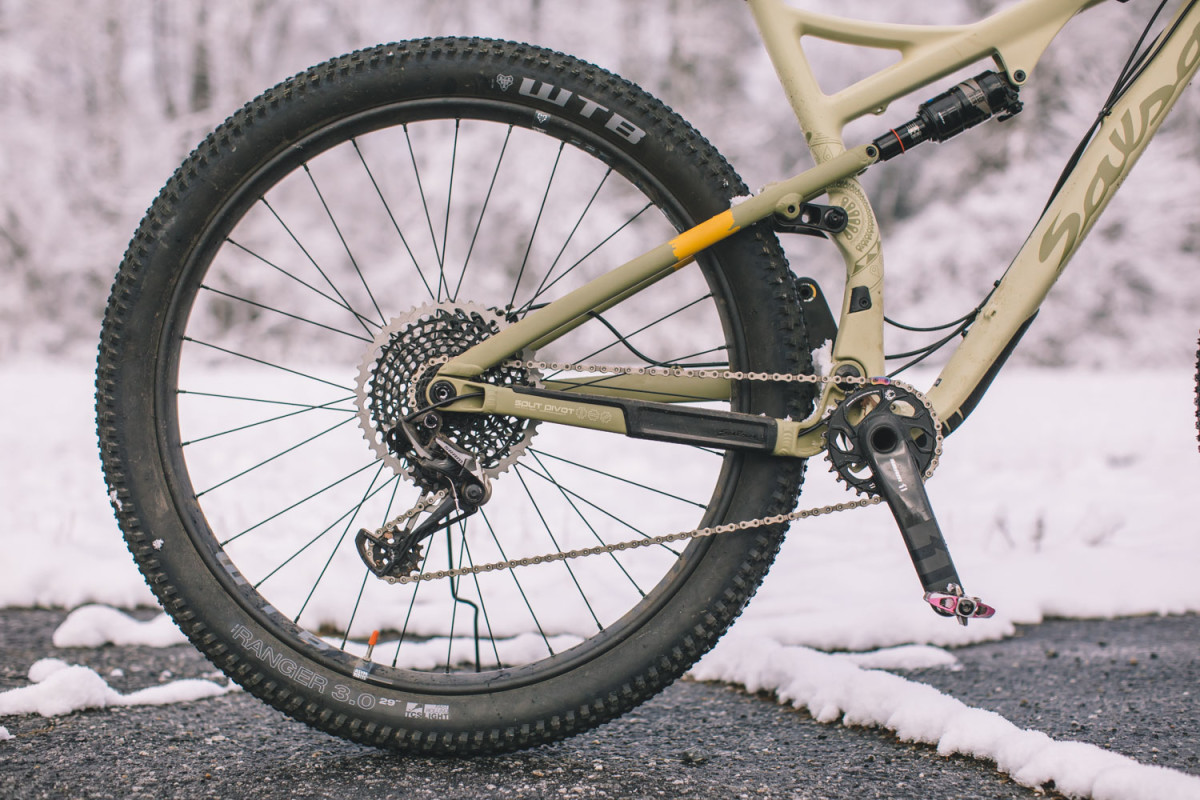
Notes on the Deadwood SUS (lg) Geometry
Headtube Angle: 68°
Seattube Angle: 74.3°
Chainstay Length: 449mm (17.7”)
BB Drop: 45mm (1.8”)
The Deadwood SUS sports a somewhat standard trail geometry. Although a 68° headtube angle doesn’t seem that slack, the fact that it’s paired with a stiff 100mm fork changes things a little. Normally with a longer travel fork and a sag percentage of 30%, some of that angle is lost when a lot of weight is over the front end. Some may argue that this balances out with the rear sag, and it probably does for the most part, but the Deadwood feels more aggressive than one might think. I felt pretty confident descending on the Deadwood SUS. With weight shifted to the back on technical downhills, the bike feels sure-footed, fast, and exceedingly capable.
While the Deadwood SUS shares a ride characteristics with the Pony Rustler — including the same frame chassis, the higher BB is a welcome change. That’s the one issue with the Pony Rustler that I find a little frustrating — to keep the cranks at a reasonable height, the Pony is limited to 3” tires (or a 29er setup). In addition the higher BB on the Deadwood leaves plenty of room to try the new breed of 29×2.6” tires or even a 2.8. In my opinion, although I didn’t get to try this, I think that could be the shining moment for the Deadwood SUS. Slightly smaller tires would not only make it much faster, lighter, and even more nimble, but also lower the stance a little and make better use of the 35mm ASYM i35s rims.
One warning. As Skyler loosely noted in the Kona Big Honzo review, the claimed seat tube angle technically may not be the true seat tube angle on bikes such as the Deadwood, where a curved seat tube is used to tuck the rear tire and shorten the chainstay. This actually changes things, especially for long-legged riders like myself. Although I am not sure what the angle is when the post is jacked to accommodate my stork-like legs, but on both the Deadwood and the Pony Rustler I slam the seat as far forward as possible in order to not have an ill-effect on my knees.
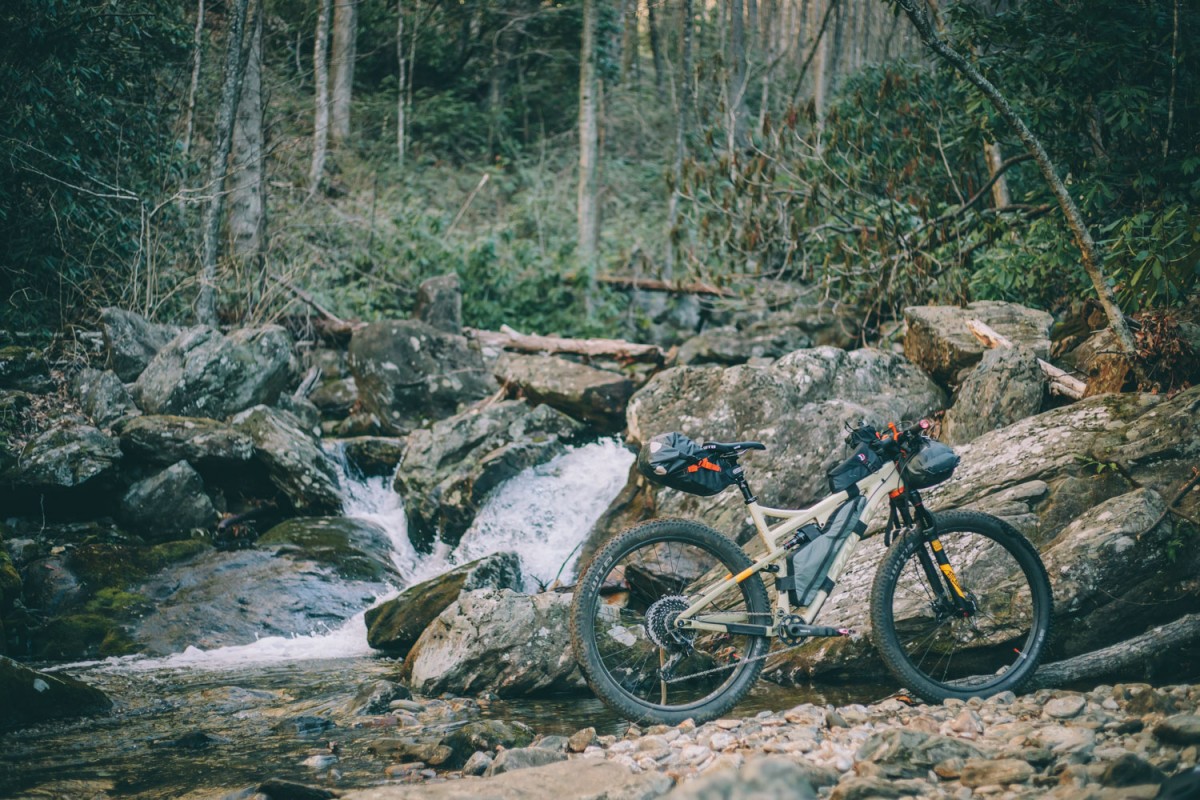
Frameset
- Frame Deadwood Carbon
- Fork RockShox Pike RC 100mm
- Color Tan
- Rear Shock RockShox Monarch RT3 w/ Debonair
Drivetrain
- Rear Der SRAM XO1 Eagle
- Cassette SRAM XO1 Eagle 10-50t
- Chain SRAM 12spd Eagle
- Crankset SRAM X1 Carbon Eagle
Components
- Headset Cane Creek 40
- Stem Salsa Guide Trail
- Handlebar Salsa Rustler Carbon
- Grips Salsa Backcountry Lock-On
- Seatpost RockShox Reverb Stealth
- Saddle WTB Volt Pro
Wheels
- Rims WTB Asym i35 Tubeless Ready Rim
- Rear Hub DTSwiss 350 148 Boost 32h
- Front Hub DTSwiss 350 110 Boost 32h
- Spokes 2.0/1.8mm butted spokes, brass nipples
- Tires WTB Ranger 29×3.0, Light Casing, Tubeless Ready
(Why) Salsa, Why?
When I look at a bike, be it full-suspension or a hardtail, I first focus on what it can do and how it will handle unloaded as a trail bike. That’s priority number one. Any bike can be a bikepacking rig. A bike you love riding on your favorite trails will likely be your perfect bike for a week-long bikepacking trip into the backcountry. But then again, I quickly turn and pore over all the details that will make it an ideal bikepacking rig too. Does it have the right suspension; can it be locked out? How about bottle cages? Solid components? A comfortable geometry? Ample frame-triangle space? The Deadwood SUS ticks most of those boxes. So why are there no bottle mounts on the bottom of the down tube? It could at least fit a fuel bottle or a tool roll. It does have a cool plastic rock guard down there with a nice ‘Adventure by Bike’ tagline, but still no bosses.
And why the 35mm inner width rims? Why not 40mm which would better match 3″ tires? According to Senior Product Manager, Joe Meiser, the WTB ASYM i35 rims were specced based on their strength — the ASYM is considered to be one of, if not the strongest wheels on the market based on their asymmetrical rim design which evenly distributes tension — and versatility to allow the Deadwood SUS to be shod with tires in the range of 2.3-3.0″. This makes sense. The Deadwood SUS has a relatively high bottom bracket and I could see this bike being really nice with some of the new 2.6″ 29er tires that are popping up. Nevertheless, I found the 3” Ranger+ tires to be a little too rounded on the i35s. While the narrow profile kept them fast-rolling, it does take away some of the traction. This was felt in the corners and on steep climbs on loose surfaces where a bigger tread patch may have held a better footing. If this were my bike to keep, I would be interested in trying it with the forthcoming Maxxis Recon 29×2.6 or the new Terrene McFly 29×2.8. Also, why the carbon handlebars? I’m not really complaining, and my fear is admittedly unfounded. They’re pretty nice, but I would either swap them for some alloy bars on a longer bikepacking trip or add a protective layer where the bags meet the carbon. I have seen bag straps rub holes in carbon over a long trip when left unprotected.
One complaint I have about the frame itself, and that of the Pony Rustler, is that the dropper cable, rear brake cable, and derailleur cable all run the length of the downtube on its top creating a web of cables to deal with. Like the Pony Rustler, the only two sections routed internally are on the seat tube to accommodate the stealth dropper post and the chainstay for the rear derailleur. It would be nice to see this cleaned up a bit with at least complete internal routing for the dropper and downtube internal routing for the derailleur.
Regarding the X01 kit that’s tested here, the main component I have a beef with is the RockShox Reverb. It’s not a bikepacking-friendly dropper post and a pain to install; I much prefer cable actuated posts such as the PNW Bachelor 150 shown in most of these pics. Aside from that and the other minor aforementioned quibbles, the build is pretty solid. The Guide RS brakes are as good a choice as any. I am perpetually impressed with the Eagle X01 1×12 drivetrain, and although this is my first extended time with the RockShox Pike, I can see why it has a devout following.

Pros
- 29+/Short-travel suspension is a really cool platform for trail riding and backcountry exploration.
- The possibility for 29×2.6″ tires via the WTB ASYM i35 rims.
- Salsa’s Split Pivot suspension design is efficient and solid.
- Eagle X01 is a great drivetrain and the range (especially the big 50t granny) pairs well with 29+.
- Graphics and details are a nice touch.
Cons
- The 35mm rims are a little narrow for full 3″ tires. While they work, the rounded profile makes them have a little less traction than those mounted on 40mm+ rims. They are faster though. And this gives the Deadwood the ability to comfortably run 2.8″ and 2.6″ tires.
- No bottle mounts on underside of downtube.
- The RockShox Reverb is not a bikepacking-friendly dropper post. I much prefer cable-actuated posts (more on this soon).
- Could use more internal cable routing to clean up the downtube.
- $6k is a lot of dough for the Eagle version; the XT 1×11 at $4499 might be a little more in reach; and with an Effect crankset and 11-46mm cassette, a reasonable granny gear for loaded bikepacking would certainly be attainable.
Details
- Frame Carbon triangle / Alloy rear
- Travel 91mm R / 100mm F
- Size Tested Large
- Build Tested X01
- Weight TBA
- Price $5999
- Best for Trail riding, week-long bikepacking trips in the backcountry, everything in between
Wrap Up
I was pretty sure I’d like the Deadwood SUS. After all, I’ve been happy with the Pony Rustler, save a couple minor grouches, and I generally love 29+. But most of the time when I psyche myself up there is a little bit of a letdown. I am pleased to report that that’s not the case this time. Sure I have some issues with it… the web of non-internally routed cables, it’s lack of under downtube mounts, and although I see the benefits of the i35 ASYM Rims, I would rather have seen Salsa commit to 3” tires with 40mm+ rims, but the Deadwood SUS is such a fun and unique ride. It can handle pretty much anything you want to point it down, and, geometrically speaking, it’s a nice blend of old reliable and trail shredder.
When it comes down to it, Salsa nailed the suspension needed to pair with big tires. The Deadwood SUS is a special breed of bike that maintains the feel of the 29+ platform yet blends modern materials and components, and the ideal amount of travel to add to the experience without taking away from it. To anyone who already has a love-affair with 29+ and is flirting with breaking out of a committed relationship with rigid steel — and even to those who don’t — I say go out and demo one. If you’re anything like me, you’ll try and smuggle it outta Dodge and head for the sunset before the sheriff takes notice.

Rider Profile
Between big trips, Logan can usually be found riding his favorite trails in Pisgah, NC, or tacking together 4 or 5 day singletrack-heavy bikepacking trips throughout the eastern US and beyond. He and his wife Virginia recently finished a trip across Cuba. The Salsa Deadwood SUS was loaned to Logan for this review.
- Height: 6’0” (183 CM)
- Weight: 170 lbs (77.1 KG)
- Inseam: 33” (83.8 CM)
- Current Location: Pisgah, NC
- Favorite Beer: Anything by Burial
- Favorite Route: Gila River Ramble
Please keep the conversation civil, constructive, and inclusive, or your comment will be removed.






